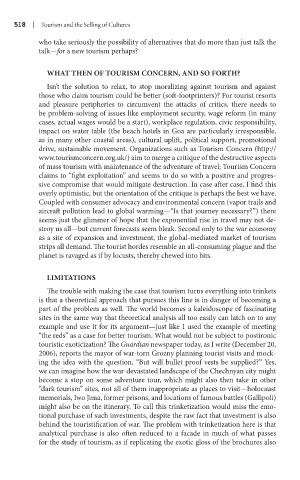Page 539 - Battleground The Media Volume 1 and 2
P. 539
1 | Tour sm and the Sell ng of Cultures
who take seriously the possibility of alternatives that do more than just talk the
talk—for a new tourism perhaps?
whaT ThEn oF Tourism ConCErn, anD so ForTh?
Isn’t the solution to relax, to stop moralizing against tourism and against
those who claim tourism could be better (soft-footprinters)? For tourist resorts
and pleasure peripheries to circumvent the attacks of critics, there needs to
be problem-solving of issues like employment security, wage reform (in many
cases, actual wages would be a start), workplace regulation, civic responsibility,
impact on water table (the beach hotels in Goa are particularly irresponsible,
as in many other coastal areas), cultural uplift, political support, promotional
drive, sustainable movement. Organizations such as Tourism Concern (http://
www.tourismconcern.org.uk/) aim to merge a critique of the destructive aspects
of mass tourism with maintenance of the adventure of travel; Tourism Concern
claims to “fight exploitation” and seems to do so with a positive and progres-
sive compromise that would mitigate destruction. In case after case, I find this
overly optimistic, but the orientation of the critique is perhaps the best we have.
Coupled with consumer advocacy and environmental concern (vapor trails and
aircraft pollution lead to global warming—“Is that journey necessary?”) there
seems just the glimmer of hope that the exponential rise in travel may not de-
stroy us all—but current forecasts seem bleak. Second only to the war economy
as a site of expansion and investment, the global-mediated market of tourism
strips all demand. The tourist hordes resemble an all-consuming plague and the
planet is ravaged as if by locusts, thereby chewed into bits.
LimiTaTions
The trouble with making the case that tourism turns everything into trinkets
is that a theoretical approach that pursues this line is in danger of becoming a
part of the problem as well. The world becomes a kaleidoscope of fascinating
sites in the same way that theoretical analysis all too easily can latch on to any
example and use it for its argument—just like I used the example of meeting
“the reds” as a case for better tourism. What would not be subject to postironic
touristic exoticization? The Guardian newspaper today, as I write (December 20,
2006), reports the mayor of war-torn Grozny planning tourist visits and mock-
ing the idea with the question, “But will bullet proof vests be supplied?” Yes,
we can imagine how the war-devastated landscape of the Chechnyan city might
become a stop on some adventure tour, which might also then take in other
“dark tourism” sites, not all of them inappropriate as places to visit—holocaust
memorials, Iwo Jima, former prisons, and locations of famous battles (Gallipoli)
might also be on the itinerary. To call this trinketization would miss the emo-
tional purchase of such investments, despite the raw fact that investment is also
behind the touristification of war. The problem with trinketization here is that
analytical purchase is also often reduced to a facade in much of what passes
for the study of tourism, as if replicating the exotic gloss of the brochures also

